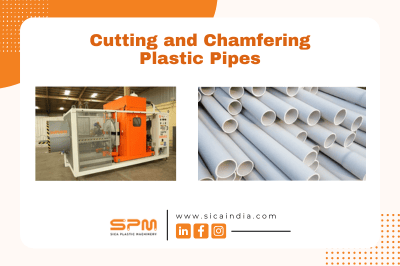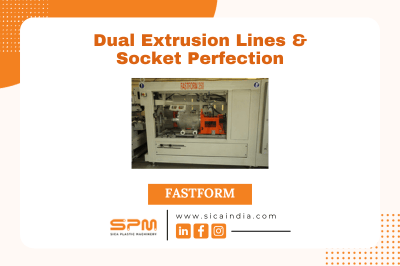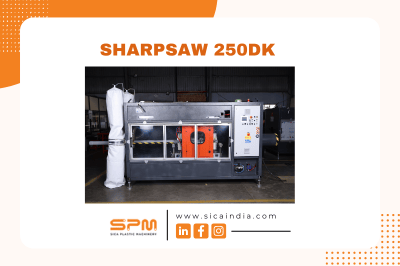Welcome to our blog series dedicated to exploring the essential components of downstream pipe extrusion lines. These machines and equipment work together seamlessly to produce high-quality pipes used in various industries. Throughout this series, we will examine each machine’s role and significance in the production process.
Cooling Trough – Efficient Cooling for High-Quality Pipes
The Cooling Trough is a critical component in downstream pipe extrusion lines. As freshly extruded pipes emerge hot from the extruder, the Cooling Trough provides controlled cooling to maintain pipe shape and integrity.
Inside the trough, pipes are passed through a water-filled channel. The circulating water absorbs heat from the pipes, rapidly reducing their temperature. This regulated cooling prevents deformation, warping, or weaknesses from uneven cooling.
The trough length allows sufficient cooling time based on the pipe type. Balancing cooling time and production speed is essential for efficiency and quality.
Proper cooling also enables better molecular alignment and mechanical properties in the pipe material, reducing internal stress. This prevents failures during later production steps or application.
Manufacturers can customize the trough’s water temperature and flow for different materials and diameters. Automated systems may also control the cooling process for consistency.
Printer/Marker – Enhancing Pipe Identification and Traceability
The Printer/Marker is an integral machine in pipe extrusion lines that marks essential information on pipe surfaces for identification and traceability. Strategically positioned, it prints details like size specifications, brand logos, production dates, and batch numbers as pipes move through the system. Automating this process brings consistency in information placement, avoiding human error and ensuring compliance.
The Printer/Marker enhances traceability by clearly identifying pipes for tracking production history and quality control. Some systems use inkjet technology for quick-drying, high-resolution printing on various materials. Durable inks withstand external factors, keeping prints intact throughout storage, transport, and installation.
Beyond identification, the Printer/Marker also serves as a branding tool by displaying manufacturer logos on pipes. This instills confidence in customers, reinforcing brand reputation for quality products. Overall, by automating durable prints, the Printer/Marker delivers pipes that meet industry expectations while promoting brand recognition in the market.
Haul-off Machine – Precision Control for Optimal Pipe Tension
The Haul-off Machine is a vital downstream component in pipe extrusion lines. It pulls the cooled pipe from the extruder at a controlled speed, maintaining tension to prevent deformation and ensure consistent sizing.
The machine uses grippers or belts to securely hold the pipe surface during pulling. The calibrated pull speed depends on the pipe type and application.
Precise speed control is critical for several reasons. First, it maintains the desired pipe dimensions and wall thickness. Second, it keeps the extruded pipe straight and uniform, avoiding performance-compromising irregularities. Third, the tension prevents stretching, sagging, or other issues during cooling and hardening.
Advanced Haul-off Machines have sensors and feedback to continuously monitor tension and speed. This allows real-time adjustments to compensate for deviations and optimize performance.
Designs vary based on production needs. High-speed lines or higher diameter lines may use multi-belt caterpillar machines for balanced, steady pulling. Lower speeds can utilize simpler, rubber-gripped beltless machines.
Pipe Cutter – Precision Cutting for Accurate Lengths
The Pipe Cutter is an integral machine in the downstream pipe production process. Its key function is cutting extruded pipes to precise, standardized lengths required for projects or applications. The Pipe Cutter contains a sharpened blade or saw that activates in sync with pipe extrusion, slicing each section of pipe once it reaches the target length. Precision cutting ensures consistency in pipe dimensions, which is crucial for proper installation and integrity in systems like plumbing infrastructure.
To optimize efficiency, manufacturers may use automation like conveyors to transport cut pipes or robotics to handle pieces post-cutting. The specific capabilities of the Pipe Cutter depend on the pipe type, as large diameter or uniquely shaped pipes need specialized, sturdy cutting mechanisms. Overall, the Pipe Cutter’s accuracy ensures quality and reduces waste by delivering pipes cut to exact specifications necessary for various end uses and easy handling. A cutter comes with several options to cater to the needs of a customer and also to be able to cut pipes made from various plastic materials like PVC, HDPE, PP and so on… A cutter comes with an optional attachment of a chamfering tools to provide a chamfer for easy fit of the pipes into a socket.
Socketing Machine – Creating Secure Pipe Joints for Versatile Applications
The Socketing Machine plays a vital role in the pipe production process. It forms specialized socket or bell ends on pipes to enable secure, leak-proof connections. This machine is especially useful for pipes used in plumbing, drainage, and sewer systems, where sturdy joints are essential.
To create the sockets, the Socketing Machine heats the pipe end using electrical heaters or hot air. Once softened, the end is shaped by molds into the desired bell or socket form. The socket is then cooled to set it permanently.
Manufacturers can customize the Socketing Machine to accommodate different pipe sizes and socket configurations per industry standards. Some machines can make both plain and threaded sockets.
Socketed pipe systems have major advantages over other joining methods. The sockets allow tight, seamless connections without separate connectors or couplings. This greatly reduces the risk of leaks while providing superior structural integrity, making socketed pipes ideal for underground installation.
By integrating the Socketing Machine into the extrusion line, pipe production stays efficient and continuous. In summary, this machine enables high-quality, leak-free socketed pipes crucial for plumbing, drainage, and sewer applications. The customized sockets ensure robust, secure pipe joints. Belling Machines can create different sized bell ends and various configurations like plain, threaded, or rubber-sealed ends. This versatility allows manufacturers to produce pipes suited for diverse applications from plumbing to sewer drainage.
Automatic Packaging Machine – Efficient Packaging for Ready-to-Ship Pipes
The final step in pipe extrusion is automatic packaging. Packaging Machines bundle or coil finished pipes for storage, transportation, and delivery.
After quality checks, pipes move to Packaging Machines. These machines efficiently and securely package pipes of varying sizes and lengths based on specifications. Customized settings meet customer requirements for bundle sizes or coil diameters.
Automated packaging increases production line efficiency. Packaging Machines quickly bundle pipes with minimal labor and handling time, reducing costs.
Packaging protects pipe quality. Materials like protective film or coatings shield pipes from damage during storage and transit. Integrated labeling provides inventory tracking.
In summary, Packaging Machines are critical to extrusion lines. Automation increases efficiency while bundling pipes securely. Proper packaging preserves pipe quality for delivery. Ultimately, Packaging Machines optimize the final production and handling process.
Quality Control and Testing Equipment – Ensuring Pipes Meet Industry Standards
Quality control and testing are critical to ensuring pipe quality in extrusion lines. Key equipment includes:
- Thickness gauges to measure wall thickness consistency for structural integrity.
- Pressure testers to evaluate ability to withstand internal/external pressure and identify leaks.
- Tensile and impact testers to determine mechanical properties like strength and impact resistance.
- Dimensional gauges to verify outer/inner diameter specifications are met for proper sizing.
- Melt flow index testers to assess material flow rate and batch consistency.
- ESCR testers to check resistance to cracking from chemicals or weather.
Rigorous testing identifies defects early for corrective action. This ensures pipes meet industry standards, customer specifications, and regulations.
In summary, quality control and testing equipment are essential in extrusion lines. Thorough testing produces high-quality, reliable pipes that perform optimally in their intended applications. This results in long-lasting, dependable solutions across industries.





